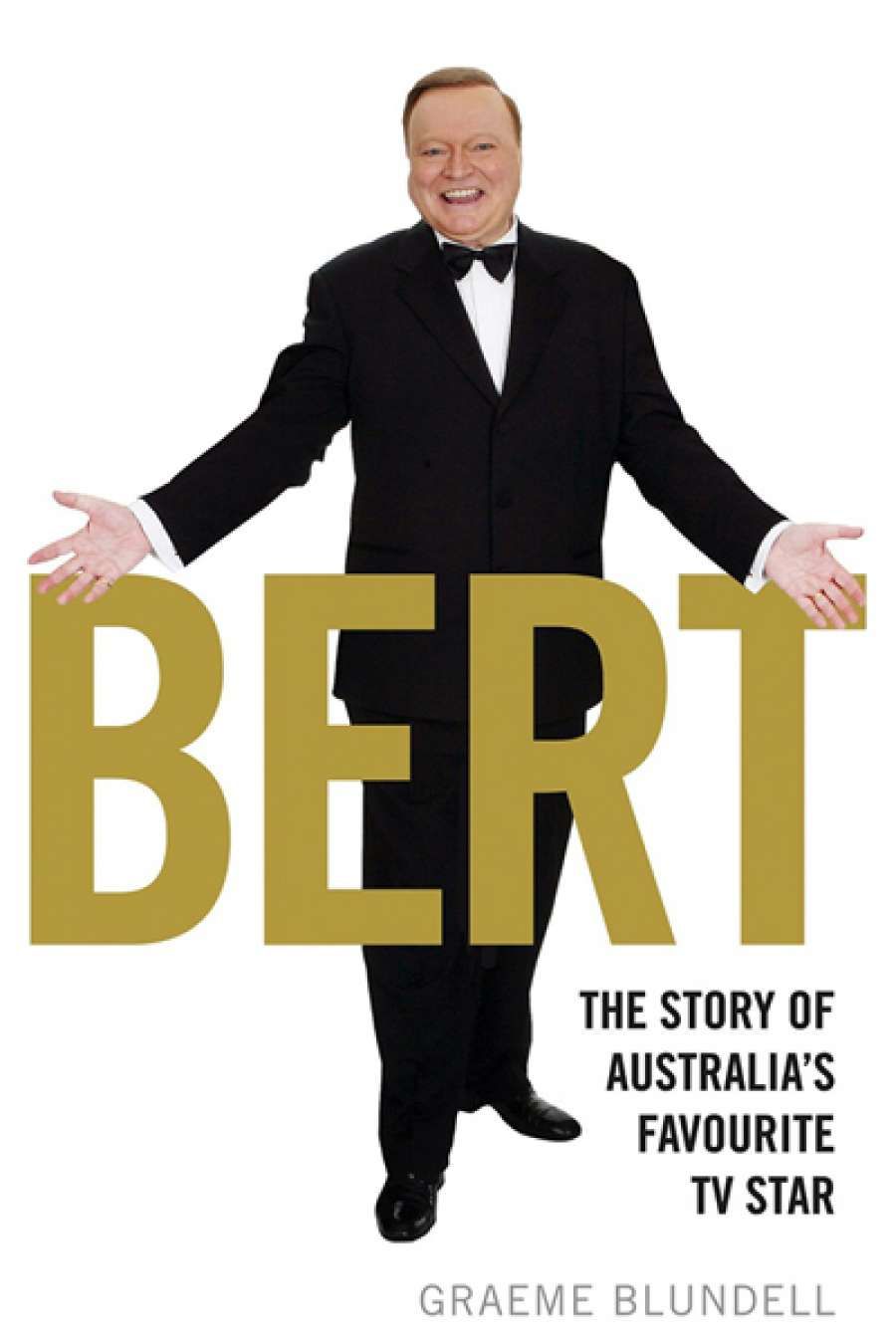
- Free Article: No
- Contents Category: Television
- Custom Article Title: Dina Ross reviews 'Bert' by Graeme Blundell
- Review Article: Yes
- Article Title: Our Bert
- Online Only: No
- Custom Highlight Text:
In the world of Australian popular entertainment, few personalities are more prominent than Bert Newton. Since the 1950s he has been a presence on radio and television, as announcer, talk show host, compère, interviewer, and musical comedy star. Love him or loathe him, ‘Old Moonface’ has impressed as much for his ability to survive the ups and downs of showbiz politics as for his body of work. Whatever fate has thrown at him, he has risen, phoenix-like, from the ashes until the expiration of his Channel Nine contract earlier this year. Graeme Blundell’s biography attempts to reveal the man behind the flashing smile and famously quick wit. He draws on news reports, personal interviews with Newton’s colleagues and friends, as well as extracts from articles and television programs, to build a composite picture of a media celebrity.
- Book 1 Title: Bert
- Book 1 Subtitle: The story of Australia’s favourite TV star
- Book 1 Biblio: Hachette, $45 hb, 376 pp
It should be noted that Bert is an ‘unauthorised biography’. It is hard to see what Newton could take issue with here. This is a straightforward, non-judgemental, factual piece of research, written with a good journalist’s keen eye for detail. We learn about Newton’s childhood in working-class Melbourne, the early death of his father, his indomitable mother, the Catholic faith that bound the family together and which is still an important part of Newton’s life.
From the age of fifteen the young Newton, with his gift of the gab, was working as a radio announcer on 3XY. By the time he was seventeen, he had successfully auditioned for Channel Seven, originally as a booth announcer, recording links between programmes. His mellifluous voice and cheeky grin soon created a buzz and he was presenting The Late Show before he turned twenty. The dapper, slender young man about town had been given his lucky break in the burgeoning industry he would dominate for the next half century.
Blundell’s insights into the early days of Australian television are fascinating. ‘Anything goes’ was the catchphrase. On rival Channel Nine, Graham Kennedy, ‘King’ of the small screen, was irreverently presenting In Melbourne Tonight (1957–70), clowning and slipping salacious innuendos into risqué asides. Kennedy, five years Newton’s senior, was a superb improviser. At first, Newton could not match Kennedy’s gift for verbal comedy, relying instead on a ‘Mr Nice Guy’ persona. But he was a quick learner, with an instinctive gift for understanding what the medium of television required. Both men dominated the airwaves, and it was only a matter of time before their talents were combined.
 Bert Newton in Sydney, Australia, 2013 (photograph by Eva Rinaldi)
Bert Newton in Sydney, Australia, 2013 (photograph by Eva Rinaldi)
When Newton joined Channel Nine in 1959, he was soon paired with Kennedy on IMT. The duo’s antics signalled a breakthrough in commercial television history. Products were mocked and pilloried in advertisements, such as one for Raoul Merton Shoes, which bore the Kennedy–Newton tagline: ‘If they’re hurtin’, they’re Raoul Merton.’ Viewers lapped it up. IMT may have contained the usual diet of interviews and variety, but what the public remembered was the sparring of the two hosts, who thrived on a diet of mockery and sharp ripostes and engaged in camp jokes known as ‘velvet humour’. Newton, as sidekick, became the ‘second banana’ to Kennedy’s magnetic presence, but the talent and staying power needed to maintain such momentum were monumental. It was also exhausting, and by his early twenties, Newton had suffered a psychological breakdown which led him to resign from Channel Nine and hospitalisation.
Blundell reveals the phenomenal staying power of the man. Four months after his collapse, Newton was back, first on radio and then on television. His appearances included the first of a long association hosting the Logies, virtually unscripted, appearances on IMT, and the disastrous, short-lived Bert Newton Show (1989) on ABC, one of several shows in his career that failed, attacked by critics for rehashing tired material and formats, instead of delving into the new.
For many, if Newton’s association with Kennedy was ground-breaking, so was his long collaboration with Don Lane. Spinning the Wheel of Fortune on The Don Lane Show twice a week became another showcase for Newton. From 1976 to1983 the glitzy show, full of interviews with stars and appearances by Hollywood celebrities, became one of the most popular on Australian television and cemented another ‘magical’ double act.
Little dirt clings to Newton. His greatest professional controversy occurred in 1979 when he accepted the Gold Logie for most popular television personality from boxer Muhammad Ali. His quip, ‘I like the boy’, was well meant but injudicious. In his more than nine lives, Newton has overcome contracts cancelled by networks that were eventually resigned, ratings slumps, and changes in popular taste, but has still, somehow, managed to reinvent himself. Even in 2013 the seventy-six-year-old was touring with the musical Grease. He clearly owes much of his staying power to his long, happy marriage to his ‘rock’, wife Patti (theirs was the first televised Australian celebrity wedding).
Blundell’s biography never takes us inside Newton’s skull, but paints the portrait of a consummate professional. He writes, ‘paradoxically, the secret of Bert’s perennial popularity is ... his unknowability’. Perhaps that’s true, but we can never be sure; Blundell did not interview Newton personally. He remains, like many stars, famous but out of reach, familiar yet forever distant.


Comments powered by CComment